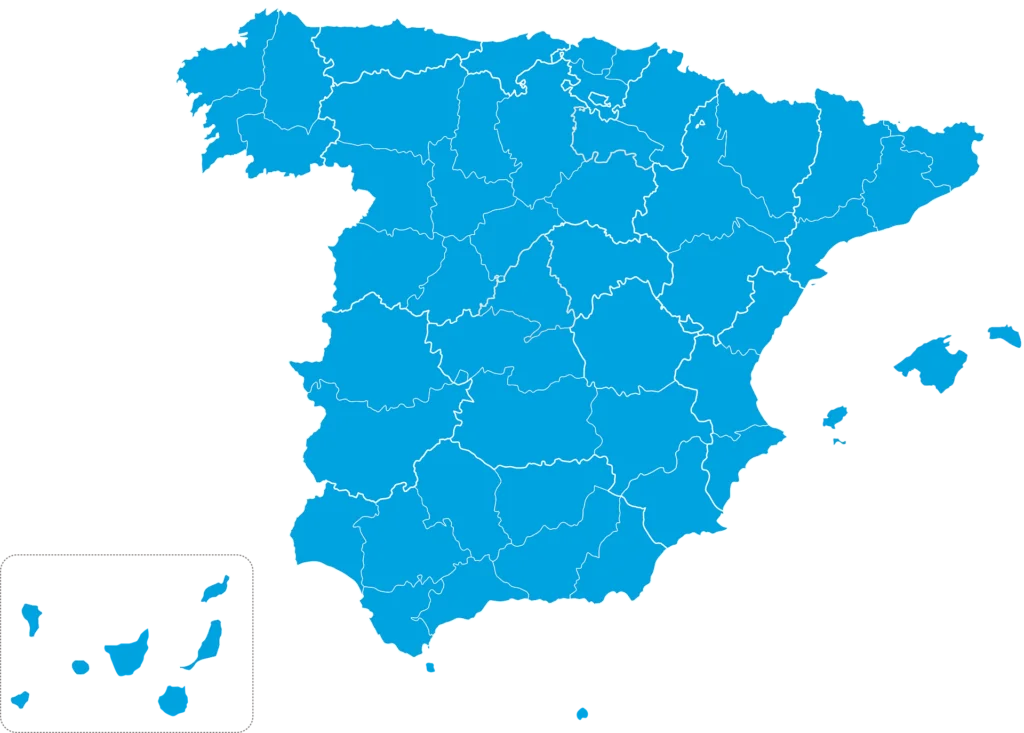With a population of 48.79 million inhabitants, different languages are spoken in Spain, both official and dialectal languages, and foreign languages (the latter predominantly among the immigrant population).
Official languages of Spain
There are six official languages in Spain: Castilian, Catalan, Valencian, Galician, Basque and Aranese (which has only 2,800 native speakers).
The most common language in Spain is Spanish which is currently spoken by 96% of the total population as their first or second language. This is followed by Catalan (14,2%), Valencian (5,8%), Galician (5.2%) and Basque (2.5%).
Spanish or Castilian
In Spain, the name Castilian is used to refer to the Spanish language. The word Castilian comes from the province of Castile in central Spain, where this language originated.
Castilian is a Romance language that emerged as a dialect in Cantabria in northern Spain and includes between 3,000 and 4,000 Arabic words. After it joined with the Kingdom of Castile and León, it became the state’s official language in the Middle Ages.
Castilian is the most prevalent language and is the only language that all the regions of Spain have in common. In all public signage, official bodies and education, Castilian is always used as the dominant language.
Catalan
Catalan is another of the Romance languages spoken in Spain and, specifically, in Catalonia in the north-east of the country. Catalan is one of the three co-official languages in Catalonia, together with Castilian and Aranese.
The history of Catalan goes back to the 8th century, and, in the 12th century, it started to extend southwards. In 1979 and 1983, Catalan was accepted as an individual language and became Catalonia’s official language.
Catalan is also spoken in Valencia (south-eastern Spain), the Balearic Islands, the east of Aragon (north-eastern Spain), the South of France and Alghero on the Italian island of Sardinia. In these regions, Catalan has different dialects that mean some speakers even think that their language is different to Catalan (this is the case of some speakers of Valencian).
Currently, 14,2% of the Spanish population speaks Catalan and it is the mother tongue of 11.1%.
Valencian
The Valencian language is the official language of the Valencian Community, as it is stated in article 6.2 of its Statute of Autonomy.
More than 50% of the population of the Valencian Community speaks Valencian and almost 95% of the total of the inhabitants understand it.
Galician
Galician is a Romance language which is primarily spoken in Galicia, in the north-west of Spain. Nearly 6.2% of the total population of Spain speaks Galician.
Galician has many similarities with Portuguese; both languages share the same origin. The vocabulary and grammar are very similar, but the pronunciation has evolved differently.
Basque
Basque is the language spoken in the Basque Country in northern Spain, where there are around 700,000 speakers.
Linguistically speaking, Basque is a language isolate that is not connected in any way with other European languages or any other living language. Only 2.5% of the inhabitants in Spain speak Basque and only 1.8% consider it their mother tongue.
Aranese
Aranese (or Occitan) is a Romance language that is predominantly spoken in Val d’Aran, the South of France, Monaco and in some areas of Italy.
Aranese is closely related with Catalan, with which it shares many linguistic characteristics and a common origin. In Spain, Aranese was considered a dialect until the Parliament of Catalonia declared it the official language in Catalonia in the year 2010.
Less than 3,000 people in Spain speak Aranese and there are only one and a half million speakers in Europe.

Minority languages in Spain
In Spain there are several minority languages that are considered non-official languages or dialects. Some of the inhabitants in these areas consider these minority languages their mother tongue.
- Aragonese: a Romance language which currently has between 30,000 and 50,000 speakers.
- Asturian: a Romance language spoken in the Principality of Asturias in the north-west of Spain by between 100,000 and 450,000 people. Asturian is taught in schools in Asturias between 6 and 18 years of age.
- Benasquese: also called patués by its speakers. It is a Romance dialect spoken in the province of Huesca in north-eastern Spain.
- Cantabrian: a group of dialects that has around 3,000 speakers. In 2009, UNESCO included Cantabrian in its list of endangered languages.
- Eonavian (Galician-Asturian): a set of dialects with approximately 45,000 speakers.
- Extremaduran: it is predominantly spoken in the autonomous community of Extremadura in western Spain by approximately 6,000 people. Its pronunciation system and grammar rules are very similar to Galician, Portuguese and Castilian.
- Fala: a Romance language spoken by some 10,000 people in the Jálama Valley, in the north-east of Extremadura.
- Leonese: a Romance dialect spoken in the province of León in north-western Spain by between 20,000 and 50,000 people. The UN considers it to be highly endangered.
- Murcian Spanish: a regional dialect of the autonomous community of Murcia in south-eastern Spain. Some of its native speakers consider it a language.
- Silbo Gomero: a whistled language based on non-verbal communication. UNESCO included Silbo Gomero in the Representative List of Intangible Cultural Heritage of Humanity in 2009.
Foreign languages spoken in Spain
According to INE, there were nearly 6 million immigrants in Spain in 2022, which accounts for around the 13% of the total population.
1.6 million people from 175 different nationalities live in Barcelona, 20% of whom are foreign residents, which means that some 300 different languages are spoken in the city.
The most spoken foreign languages in Spain are English, French and Romanian. 11.7% of the Spanish population speaks English as their mother tongue or as a foreign language.
Interestingly, Chinese immigrants are among the 10 largest immigrant communities in Spain; however, only 0.1% of the total Spanish population speaks Chinese. Is this due to the difficulties of this language or because the second generations let it fall into disuse?
Tell us what you think in the comments.
